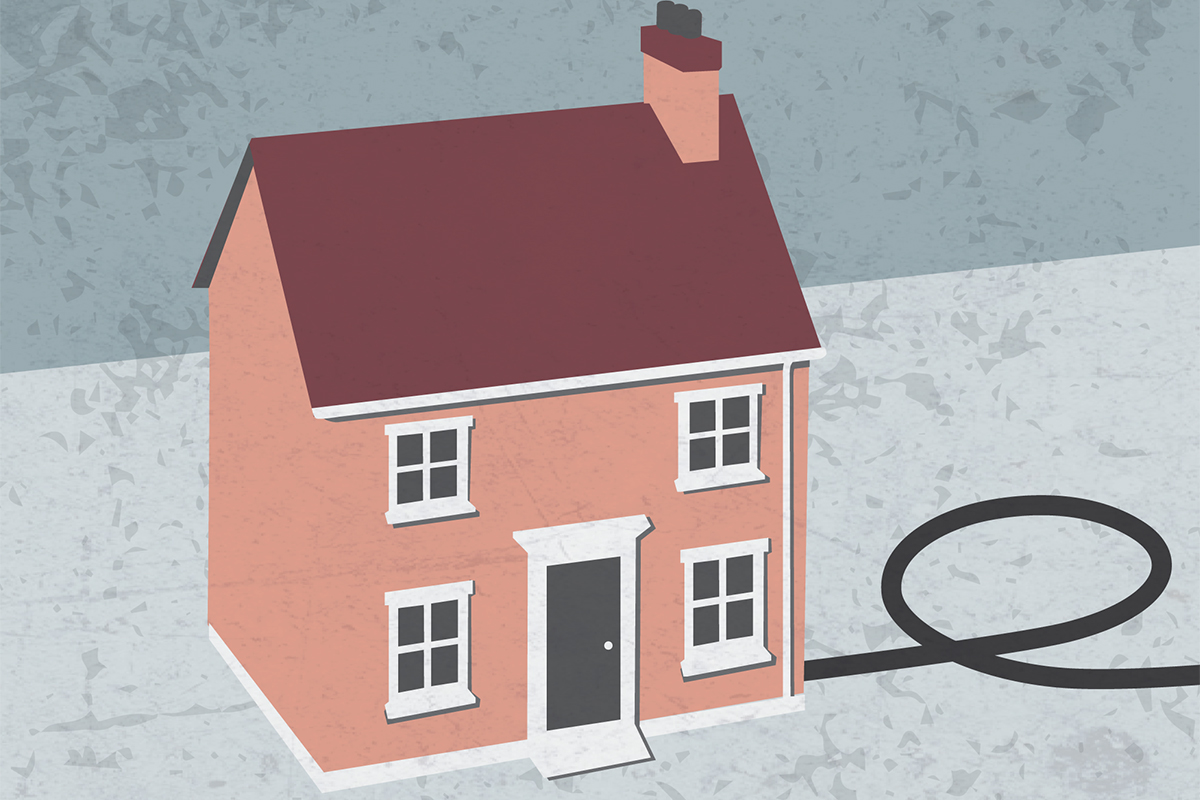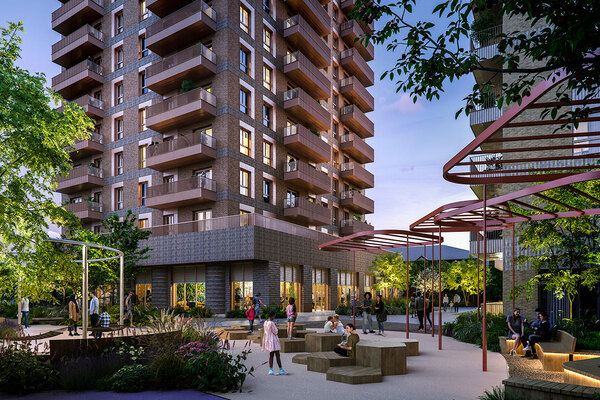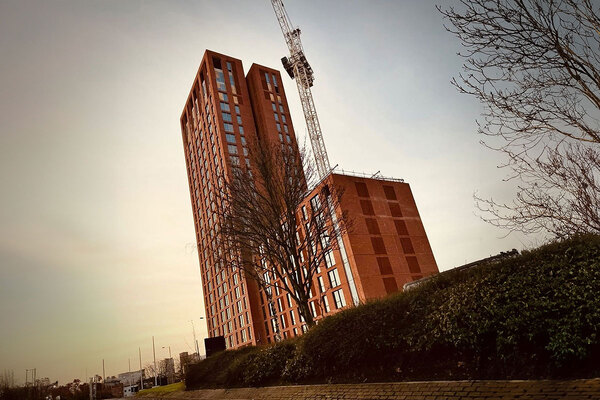Size matters: why do developers build larger homes?
Private developers have been building houses far larger than needed. Chaminda Jayanetti crunches the numbers and looks at the implications for the sector. Illustration by Jon Heal
On the eve of the financial crisis in 2008/09, one in five private sector new builds had four or more bedrooms. But in 2017/18, more than one in three did, despite the average UK household size remaining flat at 2.4 people and the average number of children per mother falling.
Private house builders have been developing larger homes than most households require. So is the surge in large private housebuilding really meeting market need or is it using up valuable land on unaffordable housing?
For Matt Thomson, head of planning at the Campaign to Protect Rural England (CPRE), the answer is clear: “We’ve noticed that over the past year to 18 months, the proportion of one and two-bedroom homes has been going down, while the proportion of four and five-bedroom-plus homes has been going up. However, the actual need for housing is almost entirely in the one, two and three-bedroom housing range.”
Neal Hudson, the founder of Residential Analysts, characterises this trend as the difference between “meeting market demand and meeting housing need”.
Barely one in five private new builds in 2017/18 had two bedrooms, while less than 10% had one bedroom, according to government data. By contrast, more than half of new builds completed by housing associations have two bedrooms and only one in 25 has more than four.
Mr Hudson pinpoints two factors here. The financial crisis resulted in developers switching from flats to larger homes, as their target cash-rich customers were more likely to buy these. More recently, Help to Buy took over, enabling first-time buyers to purchase larger homes.
Lawrence Bowles, associate director of residential research at Savills, says: “Since Help to Buy was introduced, we’ve seen house builders really changing their strategies to appeal to people who can spend a little more money than before. As a result, we’re seeing people skipping that rung on the housing ladder. We’re not seeing people moving straight into a one or a two-bed flat.”
Steve Turner, spokesperson for the Home Builders Federation, adds: “People will buy the biggest house they can afford. So you’ll see first-time buyers buying houses that are probably bigger than what their counterparts would have bought a couple of decades back, on the basis that they probably won’t be able to move again, because there won’t be 5% products when they want to shift up if they’ve bought a one-bed or a two-bed.”
However, private developers have started to offer large houses to housing associations in recent months, in an attempt to de-risk their portfolios amid uncertainties from Brexit and in the housing market.
“They’ve been offering large houses to housing associations, such as four and five-bedroom houses,” says Will Jeffwitz, policy leader at the National Housing Federation. But he adds that associations are reluctant to take these, as the bedroom tax and other limits on housing benefit, as well as low wages, mean large homes are often unaffordable.
But why do developers build bigger if the market is asking for smaller?
“There’s clearly demand or they wouldn’t do it, but whether it’s needed and warranted is another matter,” explains Melanie Rees, head of policy at the Chartered Institute of Housing.
“People will buy the biggest house they can afford” – Steve Turner, Home Builders Federation
“Obviously, as a private sector industry, it will build what people can buy,” adds Mr Turner. “And if people wish to buy a four-bed, whether they’ve got two kids or one kid, that’s what the industry will provide.”
There is another factor that comes into play, too. Some councils in deprived areas see larger housing as a way to attract middle class or wealthy young professionals, who can help spur investment and economic productivity.
“Different parts of the country need different things,” says Ms Rees. “Depending on the economic strategy in a local area, these types of home might be key in terms of attracting a skilled professional workforce to generate new businesses.”
Mr Bowles adds: “I think that’s absolutely part of the strategy for local authorities who want to attract talent – they highlight that the quality of life they offer could be a lot better than in other areas, because there will be access to higher quality housing at a lower cost.”
Mr Thomson recounts the story of one North West council that planned to build a small number of estates of large executive homes to try to attract “captains of industry – or Premier League footballers”.
Ms Rees tells a similar tale: “Where I live in Derby, when Toyota moved here 27, 28 years ago, they were building executive homes, anticipating that highly paid professionals would come to live and work in Derby and they wanted to attract them. I suspect other areas would try to do something similar. But that still doesn’t justify the sort of numbers we’re talking about here.”
Derbyshire is currently seeing a large number of private housing developments with many four and five-bedroom houses, some priced at more than half a million pounds. Inside Housing identified 20 new build private housing developments across the county comprising nearly 2,200 housing units. Of these, nearly 40% have four or five bedrooms.
Mickleover in South Derbyshire is the site of developments by numerous builders, including Barratt Homes, Redrow and David Wilson Homes. Two-thirds of the David Wilson Homes site appear to be four or five-bedroom properties offered at market rates, with the most expensive costing £540,000.
“The feedback we get from the local level is that the houses are unaffordable for local people and don’t meet their needs” – Matt Thomson, Campaign to Protect Rural England
Ms Rees describes the buyers here as “people with one or two good incomes buying properties that are much bigger than they really need”.
This kind of out-of-town location lends itself to larger homes. In 2017/18, 34% of new builds in South Derbyshire had at least four bedrooms; the previous year, it was 42%.
A spokesperson for South Derbyshire District Council says the developments “are situated in parts of the district where demand for larger houses is high”.
The government stopped collecting regional data on house sizes in 2012, at which time large housing was most common in the East Midlands and least common in London.
Mr Thomson says larger houses in the shire counties are often bought by commuters, but tend to be bought as second or holiday homes in counties such as Devon and Yorkshire.
“The houses are largely not aimed at local people,” he explains. “Even if they’re sold to people who rent them out to local people, they probably won’t be occupied in the same way as a house those people would have chosen to buy – you get people sharing houses more.”
Mr Turner insists that local authorities will ensure the mix of housing on developments reflects local need. Mr Bowles adds that local planning authorities are keen for developers to build more family homes, “so having more of those three-bed, four-bed homes and so on really ticks their boxes, too”.
But Mr Thomson claims the main reason for councils approving these developments is fear of missing their housing targets – if the government then declares their local plans are out of date, it will remove their power to manage development.
“I think there’s a limited amount [councils] can do,” says Clive Betts, Labour MP and chair of parliament’s Housing, Communities and Local Government Committee. “If they get a planning application in, you can encourage and nudge… but if you’ve got a privately owned site and somebody comes along and it’s zoned for housing in the local plan, it’s pretty difficult to say no to a developer.
“The local authority has got a limited amount of power to decide what sorts of properties get built. You can try to encourage developers, but I think it would be very difficult to actually use powers to prevent certain houses being produced.”
Mr Thomson warns that the subsequent housing mix in private developments drives local opposition to housebuilding. “The feedback we get from the local level is that the houses are unaffordable for local people and don’t meet their needs.”
In a sector wearied by years of nimbyism, not everyone is convinced that opposition to housebuilding is down to affordability. Mr Hudson says that if developments consisted of cheaper housing, people would simply object on other grounds instead.
“I think there’s a limited amount councils can do. If you’ve got a privately owned site and somebody comes along and it’s zoned for housing in the local plan, it’s pretty difficult to say no to a developer” – Clive Betts, MP
“There is always that kind of opposition,” agrees Mr Thomson. “I’m sure there are people who use that kind of excuse to oppose development and probably would also support CPRE.
“If people are worried about a lack of infrastructure, then development could help to pay for infrastructure. If people are worried about the kind of people moving into their area, then they are probably just obstreperous people you shouldn’t listen to.
“But most of it is fuelled by the fact development often fails to meet local needs and is often appallingly designed. People are usually happy with good development.”
Change is afoot, however. From April 2021, Help to Buy’s £600,000 national cap on eligible house prices will be replaced by regional caps. The East Midlands cap will be £261,900 – well below the price of the four and five-bedroom homes springing up in Derbyshire.
“It is less than half the current cap and that’s clearly going to have an effect on what house builders are putting out,” says Mr Bowles.
“We suspect those private enterprise completions are going to move back towards those smaller units and a greater focus on flats, as those house builders recognise that if you’re trying to tap into that Help to Buy market, you will have to focus on those smaller units. Maybe we will see a return to that typical first-time buyer property.
“We’ve got more than £11bn spent on Help to Buy so far. Perhaps there is a growing recognition within government that that money might be better spent on affordable housing and helping people who are assessed as being in genuine housing need.”
He adds that there is already anecdotal evidence of house builders redrawing plans.
Mr Bowles thinks the reforms will shift where developments are located within regions as well – with some large-size housebuilding likely to survive. “We’re likely to see more development in those areas that are lower value within those regions.
“Because the caps are set at a regional level, if you go to a higher value market within that region, that cap becomes much more of an obstacle, whereas if you are in a lower value part of that region, you can continue building those four-bed houses all day long.”
While the change might rebalance the numbers, it remains to be seen if it will restore affordability to the housing market.












